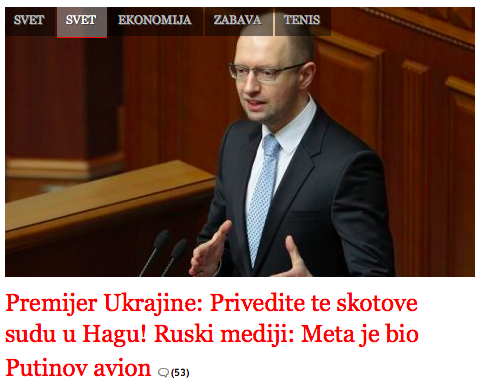By Lily Lynch and Sonja Srdanović
On Friday, as the UN Security Council convened for an emergency meeting on the downing of Malaysian Airlines Flight MH17 by alleged pro-Russian separatists in Ukraine, Serbia’s major daily newspaper Blic ran a provocative headline calibrated to stir both Serbian nationalist and pro-Russian sentiments. The top news story read: “Ukrainian Premier: Take the Bastards to the Court in the Hague! Russian Media: Target was Putin’s Plane”. The headline was accompanied by a photo of a stern-looking Prime Minister Yatsenyuk gesticulating at a lectern.
What’s significant about the headline is that the Hague tribunal remains extremely unpopular in Serbia. Many see the court as little more than a symbol of anti-Serb bias and the selectivity of “international justice” — high-ranking Croatian generals and prominent Kosovar Albanian politicians walk free, while some of the Serbian accused still languish in a seaside prison in Scheveningen after 11 years of verdictless detention. Though many in Serbia have grown increasingly indifferent to the aging men in the Hague who helped lead the country into a series of devastating, and ultimately self-destructive wars in the 1990s, the court itself is resented by a majority of the public. A 2012 study conducted by the OSCE and the Belgrade Centre for Human Rights revealed that 70 percent of Serbs polled had negative attitudes about the tribunal.
Headlines like “Take the Bastards to the Court in the Hague” attempt to position Ukraine and its new government as Serbia’s enemy, and Russians or pro-Russian rebels as its natural allies, similarly persecuted by the West and threatened by pro-Western neighbors. If the media wasn’t so busy hammering these points home, some in Serbia might figure out that Ukrainians are also their “Slavic Orthodox brothers”.

The Serbian mainstream media has been obediently promulgating the Kremlin’s increasingly erratic accounts of the downing of Malaysian Airlines Flight MH17 in eastern Ukraine since news of the crash was first reported on Thursday. Blic, owned by Ringier Axel-Springer, is probably the most widely-read newspaper in Serbia. A few hours after the crash, the German-owned media outlet republished an article from RT alleging that Vladimir Putin’s presidential plane had been in the same airspace as MH17 on its way back from Brazil, and had missed the doomed aircraft by a margin of less than one hour.
Blic used images of Putin’s presidential plane and Malaysian Airline’s Boeing to illustrate the supposed similarity of the planes the rebels were targeting from the ground. Both had a red and blue insignia on the tail, and red and blue stripes along the fuselage. The key difference is that one says “RUSSIA” in Cyrillic, while the other says “MALAYSIA” in Latin. They’re also two completely different models of aircraft. Nonetheless, RT reported that an anonymous source had described them as “almost identical” for Interfax News Agency.

Kurir, a tabloid widely known as a Serbian “government mouthpiece”, also quoted a Spanish “dispatcher” who claimed that it was impossible for Ukrainian President Poroshenko to have known that MH17 had been shot down “so quickly” after it disappeared from radar. The same publication also alleged that Ukrainian military jets were flying alongside the Malaysian Airlines plane three minutes prior to its disappearance. Once again, the story was taken from RT.
Serbia’s Pravda also published one of the more outrageous MH17 tales concocted by Kremlin PR men or fabulist rebels: In a bizarre post on VK.com — the Russian equivalent of Facebook popular across much of the former Soviet Union — Igor Strelkov, the rebel leader of the separatist Donetsk People’s Republic, wrote that the bodies of MH17 crash victims were “bloodless” and suggested that some passengers must have been dead before the plane was shot down. The Serbian Pravda published an article presenting this dimmest of conspiracy theories under the headline, “Strelkov: We have information that the plane was full of corpses!”

Russia knows keeping the memory of the violence, conspiracies, and humiliations of the 1990s alive helps secure Serbia’s commitment to lucrative business deals like the South Stream project, which Prime Minister Vucic agreed to sign when he was in Moscow on July 7th. “South Stream is a priority project for Russia, and this has become evident in the context of developments in Ukraine,” Prime Minister Medvedev reportedly said at the meeting.
By sharing the same media narratives and invoking old injustices, Russia can help keep its compliant vassals in Belgrade in power. The new Serbian government has been praised by the EU and the US Congress for “normalizing” relations with Kosovo and laying the groundwork for the eventual recognition of its independence. But Russia may also have seized upon the change of diplomatic course in Serbia as an opportunity to drop its “principled” stance on sovereignty and flip the “Kosovo precedent” in its favor at last in order to annex Crimea — and any territory beyond.
As Russian leaders have been warning for the last century, “we cannot be bigger Serbs than the Serbs themselves.”

